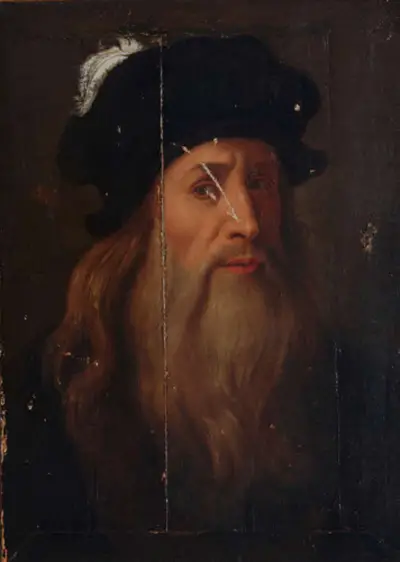The work is painted in tempera grassa on a panel and was discovered in 2008 in Italy, in the cupboard of a private house.
The owners thought the work was a representation of Galileo, but claims have been made that the work is a Leonardo da Vinci self-portrait.
The director of the Museao Ideale Leonardo da Vinci, Alessandro Vezzosi, dismissed this idea, but stated that the Lucan Portrait 'remains intriguing because it adds a new element to the Leonardo puzzle'.
The Lucan Portrait is painted using tempera grassa on a 60 x 44 cm poplar wooden panel. Tempera, also titled egg tempera, is a permanent and fast-drying painting medium consisting of coloured pigments combined with a water-soluble binding agent, such as egg yolk.
Temper grassa has the addition of oil in a maximum ratio of 1:1 with the egg yolk. This produces a water-soluble medium with many of the colour effects of oil paint. Tempera paintings last very long, with examples from the first century AD continuing to exist. This medium was the primary method of painting until after 1500, when it became replaced by oil paint.
The Lucan Painting features a man in a three-quarter view. The sitter, who has pale skin, blue eyes and long, greying hair and beard, has his gaze turned toward the viewer. He wears dark garments and a black hat with a white feather, which is believed to be a later addition.
The figure is set against a dark background and is lit brightly from the left of the picture; this illuminates the right side of his face while the left side is cast in shadow. The subject's left eye and cheek, and possibly the mouth, have been repainted at some point.
Nicola Barbatelli, director of the Museo delle Antiche Genti di Lucania, discovered the painting in 2008. Barbatelli titled the piece Lucan Portrait, from Lucania, the ancient name of Basilicata, in Southern Italy. The painting received an initial examination by Alessandro Vezzosi, director of the Museo Ideale Leonardo da Vinci.
Vezzosi investigated the possibility that the painting was the work of Cristofano dell'Altissimo, but eventually concluded the piece to have been produced by Leonardo da Vinci in the Renaissance period.
There have been numerous investigations into the claim that the Lucan portrait is by the work of Leonardo da Vinci, including one funded by the Vaglia Basilicata City Council. The painting continues to be attributed to Leonardo da Vinci.
The previous owners of the Lucan Portrait assumed the work to depict Galileo Galilai, the Italian polymath.
However, upon the painting's discovery in 2008 there were comparisons made between the painting and a portrait featuring Leonardo da Vinci in the Uffizi Gallery, leading to suggestions that the work was a self-portrait by Leonardo da Vinci.
After his analysis of the work, Alessandro Vezzosi was quoted as declaring that 'I have excluded the possibility that we are dealing with a self-portrait painted by Leonardo da Vinci'.
The Lucan Portrait is owned by, and located at, the Museo delle Antiche Genti di Lucania in the Southern Italian region of Basilicata.


